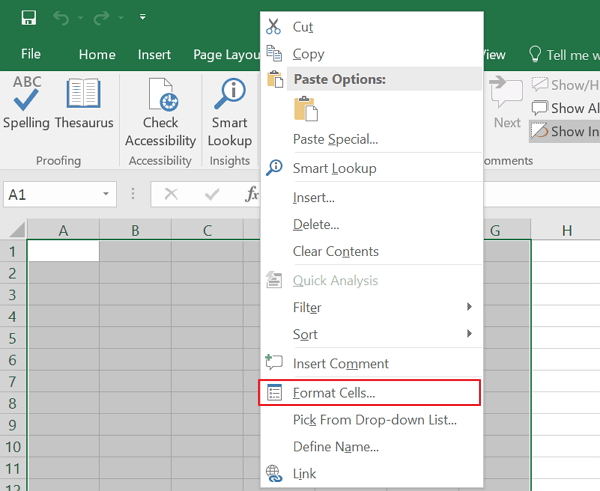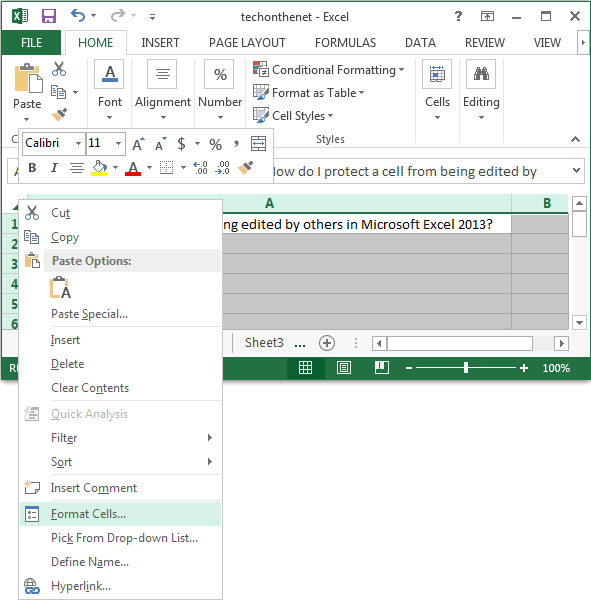

- #HOW TO LOCK INDIVIDUAL CELLS IN EXCEL 2013 HOW TO#
- #HOW TO LOCK INDIVIDUAL CELLS IN EXCEL 2013 PASSWORD#
#HOW TO LOCK INDIVIDUAL CELLS IN EXCEL 2013 PASSWORD#
In the “Protect Sheet” menu, you can create a password to protect the sheet and select a number of different parameters. In the ribbon under the “Review” tab, select “Protect Sheet.” In the Excel ribbon toolbar, click “Review.”

That’s because, in order for locking cells to work, you must also protect your sheet or workbook. Protecting the SheetĪfter you lock the cell, you’ll notice that it still lets you change the text or delete content. Once you’ve finished locking your cells, you need to protect your workbook. If you ever need to unlock them, perform the steps above in reverse. This performs the exact same function as locking cells in the format tab.Īfter that, your cells are locked. Click OK and now the data in your selected. On the Number tab, choose the Custom category and enter three semicolons ( ) without the parentheses into the Type box. Right-click to choose Format Cells option from the drop-down menu. Select the cells that contain sensitive data you want to hide. In the “Protection” tab, click the checkbox that says “Locked” to enable cell locking. Open your Excel spreadsheet in Excel 2016. In that menu, select “Format Cells.” In the “Format Cells” box, click the “Protection” tab. You can still edit all other cells.An alternative way to lock cells is to select your cells, then right-click them to bring up a menu. The password for the downloadable Excel file is "easy". To edit these cells, you have to unprotect the sheet. On the Protection tab, check the Locked check box and click OK.Īgain, locking cells has no effect until you protect the worksheet.Ĭell A1 and cell A2 are locked now. Right click, and then click Format Cells (or press CTRL + 1).Ħ. When you’re working on a spreadsheet in Microsoft Excel, locking your cells is crucial to protecting data, preventing mistakes, and more. If you want the ranges B2:B6 and D2:D6 to share a password, you can select B2:B6 as described in step 4 earlier in this article, type a comma in the New Range dialog box, and then select the range D2:D6 before you assign the password. For example, select cell A1 and cell A2.ĥ. The range that you protect with a password does not have to be made of adjacent cells. On the Protection tab, uncheck the Locked check box and click OK.Ĥ. Place a checkmark next to the field labeled 'Locked. Right-click on your cell selections, and select 'Format Cells' from the drop-down menu. Select the cells in the spreadsheet that you want to. Follow these steps to unlock cells on a spreadsheet: 1. Then, you must turn on protection on the entire spreadsheet for the 'lock' to go into effect. You must first select and unlock the cells. Select one or all of the cells you want locked. Locking cells in an Excel spreadsheet is a two-step process. However, locking cells has no effect until you protect the worksheet. To lock specific cells in Excel, first unlock all cells. Open the Excel document that contains the cell or cells you want to lock. You can lock cells in Excel if you want to protect cells from being edited. When you start using data tables in Excel, many users are frustrated to discover that the normal methods for freezing the row or column references don.
#HOW TO LOCK INDIVIDUAL CELLS IN EXCEL 2013 HOW TO#
Press Ctrl + A or click the Select All button to select the. Most Excel users figure out how to lock these references by either toggling through the options with the F4 key or using the (dollar sign) symbol in front of the column and/or row references. When you click a cell, the intersection of cells above it and cells on the left of it will be specified as the panes to freeze. Freeze Panes allows you to freeze a specified range of cells, but not in a direct way. That is why, in order to lock certain cells in Excel, you need to unlock all cells first. If you want to freeze a specified area of cells, you’d better make use of the feature Freeze Panes. By default, the Locked option is enabled for all cells on the sheet. To unprotect a worksheet, right click on the worksheet tab and click Unprotect Sheet. The detailed steps to lock cells in Excel 2010, Excel 2013 and Excel 2016 follow below. On the Protection tab, you can verify that all cells are locked by default.Īll cells are locked now.

Right click, and then click Format Cells (or press CTRL + 1).ģ.


 0 kommentar(er)
0 kommentar(er)
